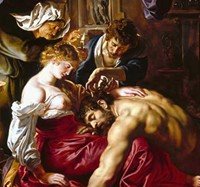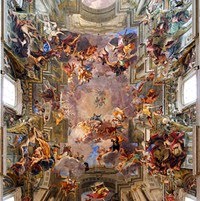BARAQUE ART
DEFINITION OF BARAQUE ART ( C.1600-1800 )
The Apotheosis of St Ignatius
(1694) San Ignazio, Rome, by Pozzo.
One of the Baroque's most inspiring
religious paintings ever created.
(1694) San Ignazio, Rome, by Pozzo.
One of the Baroque's most inspiring
religious paintings ever created.
- the term Baroque (derived from the Portuguese 'barocco' meaning, 'irregular pearl or stone') describes a fairly complex idiom, originating in Rome, which flowered during the period c.1590-1720, and which embraced painting, and sculpture as well as architecture.
- After the idealism of the Renaissance (c.1400-1530), and the slightly 'forced' nature of Mannerism (c.1530-1600), Baroque art above all reflected the religious tensions of the age - notably the desire of the Catholic Church in Rome (as Annunciation at the Council of Trent, 1545-63) to reassert itself in the wake of the Protestant Reformation.
- Thus it is almost synonymous with Catholic Counter-Reformation Art of the period.
Styles/Types of Baroque Art
- Baroque painting illustrated key elements of Catholic dogma, either directly in Biblical works or indirectly in mythological or allegorical compositions.
- Painters typically portrayed a strong sense of movement, using swirling spirals and upward diagonals, and strong sumptuous colour schemes, in order to dazzle and surprise.
- Boroque sculpture, typically larger-than-life size, is marked by a similar sense of dynamic movement, along with an active use of space.
- Baraque architecture was designed to create spectacle and illusion. Thus the straight lines of the Renaissance were replaced with flowing curves, while domes/roofs were enlarged, and interiors carefully constructed to produce spectacular effects of light and shade.
- It was an emotional style, which, wherever possible, exploited the theatrical potential of the urban landscape - as illustrated by St Peter's Square (1656-67) in Rome.
The artists of the Baroque art
1. Gian Lorenzo Bernini (1598-1680)
- one of the leading artists of the Baroque art. Architect, painter, and also set designer, he worked for the Cardinal Scipione Borghese, who commissioned him four sculptures which still today are considered to be Baroque masterpieces: “Aeneas, Anchises and Ascanius”; “The Rape of Proserpina”; “David” and “Apollo and Daphne” (all now displayed in the Borghese Gallery in Rome). Bernini was a socialite, maybe the first starchitect in history; he was as brilliant as he was arrogant.
- is the other great Baroque architect together with Bernini, with whom he worked on the plans for St. Peter’s Baldachin, but with whom Borromini would be in dispute all his life.
- Perfectionist and introvert, Borromini risked being overshadowed by Bernini all his life.
3. Caravaggio Michelangelo merisi da (1573-1610)
- Who had idealized both the human and religious experience. Although he drew some inspiration from the Carracci family, Caravaggio can be said almost single-handedly to have created the Baroque style.
- Contarelli Chapel Caravaggio's realistic naturalism first fully appeared in three scenes he created of the life of St. Matthew.
- The works caused public outcry because of their realistic and dramatic nature.
- The dark and urgent nature of his paintings at this time must have reflected Caravaggio's desperate state of mind.
- Much of the Baroque keyboard music written for the harpsichord and clavichord was written in suites comprising separate dance pieces, changing in tempo and meter but maintaining key unity throughout.
- The suite (Italian: Partita, Sonata da Camera; German: Suite, Partita, Overture; French: Order, Suite; English: Lessons).
- Other forms of keyboard music from the Baroque period are theme and variations, passacaglia, chaconne, invention, prelude, fugue, choral prelude, ricercare, fantasy, toccata and concerto.
- The two best known Baroque composers are Johann Sebastian Bach and George Frederick Handel, both Germans.
Some general characteristics of Baroque Music are:
MELODY: A single melodic idea.
RHYTHM: Continuous rhythmic drive.
TEXTURE: Balance of Homophonic (melody with chordal harmony) and polyphonic textures.
TIMBRE: Orchestral - strings, winds and harpsichord with very little percussion.
DYNAMICS: Abrupt shifts from loud to soft - achieved by adding or subtracting instruments.
*An overall characteristic of Baroque Music is that a single musical piece tended to project a single mood or expression of feeling.




Comments
Post a Comment